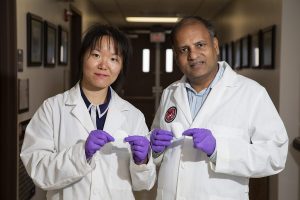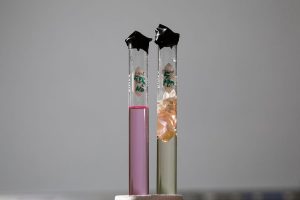A green, renewable, and environmentally friendly strategy to remove toxic dye from wastewater.

Professor Seshadri Ramkumar and doctoral candidate Lihua Lou with their nanofiber filters. Image credit: Texas Tech University.
Whether we recognize it or not, fashion is ingrained in our everyday lives, and unfortunately, so is textile waste and its downstream consequences. As a result of “fast fashion”, clothing has become more affordable and therefore more accessible, leading people to scramble after new trends and, perhaps unknowingly, leave a trail of waste and pollution behind them.
Textile dyeing is the second largest global polluter of clean water, after agriculture. Since our water sources are finite and without action, the challenges of accessing clean drinking water will only increase—by 2050 global demand for freshwater is expected to increase by one-third.
While mitigating these practices is vitally important, developing strategies to clean wastewater could provide a useful solution to the waste already being produced.
Approximately 20 000 tons of water contaminated as a result of fabric dying processes are produced each year. Alarmingly, most synthetic dyes persist in the environment because of the inefficient wastewater treatment processes and the fact that the dyes are designed to hold up to light, temperature, and detergents—the very things that might be used to clean them.
In order to address this challenge, Professor Seshadri Ramkumar at Texas Tech Department of Environmental Toxicology and lead scientist at the Nonwovens and Advanced Materials Laboratory, and doctoral candidate Lihua Lou have found a safer, affordable, and sustainable means of removing toxic dye from wastewater using nanofiber webs and visible light.
“One of the main reasons, the textile materials processing industry keeps moving from developed to developing economies is due to [a lack of] environmental protection,” says Ramkumar. “[Our strategy] is green, renewable and environmentally friendly. Using visible light for photodegradation is not harmful, and it’s cost-effective and easy to operate. It makes the color removal in the industry economical.”
Photocatalytic nanofiber webs present a promising sustainable strategy for the photodegradation of organic pollutants, such as dyes and pigments, as they have small diameters and pore size, and customizable physicochemical characteristics.
For this study, the team added TiO2 nanoparticles into a polymer solution, which was then electrospun into nanofibers. The addition of TiO2 greatly improves the degradation rate of organic pigments and dyes, and enhances other desirable traits such as antibacterial and antifouling properties, as well as wettability of the filters.

Left, water contaminated with dye. Right, functionalized nanofiber web degrades toxic dye, showing change in color. Image credit: Texas Tech University.
When the composite nanoparticle/nanofiber webs were immersed in water containing a red dye called Rhodamine B (RhB) and irradiated with visible light (546 nm), the researchers found that 80% of RhB was degraded within six hours, and the remaining 20% degraded slowly over the next 49 days.
“Some dyes are highly mutagenic and toxic,” Lou explained. “RhB is a highly water‐soluble chemical compound and widely used colorant in textiles. However, the wastewater with RhB may cause irritation to the skin, eyes and respiratory tracts of human beings and animals. Moreover, several health issues, such as neurotoxicity, carcinogenicity, reproductive and developmental toxicity arise due to RhB wastewater.”
Based on their success, the team plans to apply their method to other types of synthetic and natural dyes, including methyl orange, methylene blue and reactive blue 19.
These results are important as removing color compounds is one of the most difficult tasks in water treatment.
“These results showcase the potential of this method for developing detoxifying filters for the dyeing, finishing and textile sectors. Our research is multidisciplinary and addresses an important problem for the global textile sector,” adds Ramkumar. “After finishing the photodegradation process, the composite can be easily removed from water without leaving harmful residues. [This is a] success, but to make the research as a commercial viability, we need to put in additional work.”
About the Nonwovens and Advanced Materials Laboratory
Ramkumar’s laboratory has been carrying out research with nanofibers and advanced fibrous materials for two decades. Early work included the creation of FiberTect, a nonwoven decontamination wipe capable of cleaning highly toxic chemical agents. More recent work has involved the development of environmentally friendly oil absorbent wipes and the incorporation of natural biocides in nanofibers to develop materials that can be used in wound healing.

